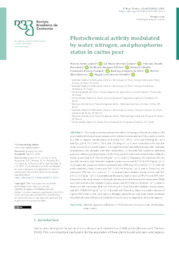Photochemical activity modulated by water, nitrogen, and phosphorus status in cactus pear.
Photochemical activity modulated by water, nitrogen, and phosphorus status in cactus pear.
Author(s): LOPES, M. N.; GOMES, G. M. F.; MARANHÃO, T. D.; SILVEIRA, W. M.; POMPEU, R. C. F. F.; SILVA, R. G. da; BEZERRA, M. A.; CÂNDIDO, M. J. D.
Summary: This study aimed to evaluate the effects of nitrogen (N) and phosphorus (P) associated with dry and rainy seasons on the photochemical activity of Opuntia ficus-indica (L.) Mill. cv. Gigante. Combinations of N (10.0, 70.0, 100.0, 130.0, and 190.0 kg ha-1 yr-1) and P2O5 (10.0, 70.0, 100.0, 130.0, and 190.0 kg ha -1 yr -1) were evaluated in the dry and rainy seasons in semi-arid regions. A completely randomized block design with split-plot arrangement was adopted with four replications. In Quixadá, the maximum potential quantum efficiency of photosystem II (Fv/Fm) was 0.82, observed in third-order cladodes (rainy season and N/P 75.6/10.0 kg ha -1 yr -1), while in Tejuçuoca, the maximum Fv/Fm was 0.81, found in 2nd/3rd order cladodes (rainy season and N/P 10.0/190.0 kg ha -1 yr -1). In Quixadá, the maximum electron transport rate (ETR) was 31.6 -mol m -2 s -1 in 2nd/3rd order cladodes (rainy season and N/P 10.0/190.0 kg ha -1 yr -1), and in Tejuçuoca, the maximum ETR was 24.1 -mol m -2 s -1, in second-order cladodes (rainy season and N/P 110.1/10.0 kg ha -1 yr -1). In Quixadá and Tejuçuoca, higher values of Fv/Fm and ETR were observed in the rainy season. In Quixadá, the maximum fluorescence decrease ratio (FDR) was 4.04 in third-order cladodes (rainy season and N/P 10.0/114.8 kg ha -1 yr -1), while in Tejuçuoca, the maximum FDR was 6.93, found in 2nd/3rd order cladodes (rainy season and N/P 190.0/10.0 kg ha -1 yr -1). In Quixadá and Tejuçuoca, there was predominance of higher FDR values in the rainy season. Nitrogen, phosphorus, and water status modulate the photochemical efficiency of cladodes of cactus pear cv. Gigante in semi-arid regions.
Publication year: 2021
Types of publication: Journal article
Unit: Embrapa Goats & Sheep
Observation
Some of Embrapa's publications are published as ePub files. To read them, use or download one of the following free software options to your computer or mobile device. Android: Google Play Books; IOS: iBooks; Windows and Linux: Calibre.
Access other publications
Access the Agricultural Research Database (BDPA) to consult Embrapa's full library collection and records.
Visit Embrapa Bookstore to purchase books and other publications sold by Embrapa.

